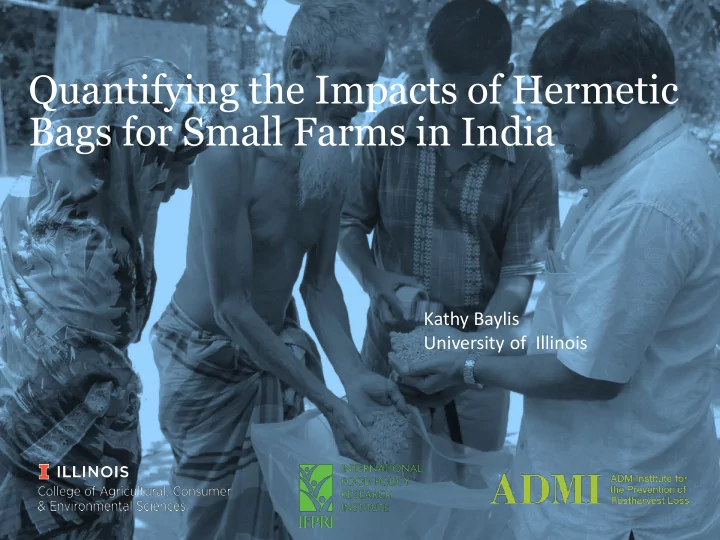

Quantifying the Impacts of Hermetic Bags for Small Farms in India Kathy Baylis University of Illinois
Research Question Can improved storage technology address all four dimensions of food security? Economic and UTILIZATION of AVAILABILITY Affordable safe food for a of Quality Food ACCESS to Food healthy life STABILITY over Time
Theory of Change Availability Access Stability Increased Storage Duration & Arbitrage Utilization
Project Overview Key Beneficiaries • 4000 HHs across 80 villages in 5 districts of the state of Bihar in India • Annual per capita income of sampled farmers is USD 230 • 90 percent of cropped area is under food grains (rice, wheat, maize) • 83 percent of farmers have less than 1 hectare land
What did we do? 1. AVAILABILITY a) Physical loss measurements and quality testing 2. Economic and Affordable ACCESS a) Storage experiment for price incentives for improved storage b) Estimation of quality premia through trader field experiment c) Choice experiment on end-users’ willingness to pay for quality and certification 3. UTILIZATION a) Aflatoxin testing and use of fumigants during storage 4. STABILITY a) Comparing storage and use duration Mar Jun Jun Aug Nov Jul Dec Jul Dec 2018 Jul 2017 2016 2018 2018 2015 2016 2016 2018 2018 BDM Auction Midline + BDM Physical End-User (Round 2) + Baseline "Mystery Aflatoxin Storage Endline Bag use Auction Loss Choice Aflatoxin Survey Seller" testing Expt Survey (Round 1) Expt Expt testing
AVAILABILITY: Physical Losses Measurement
AVAILABILITY: Lower Physical Losses • Low self-reported losses from farmers (2 to 3%) • Measured quantity losses • 3-4% during harvesting • 11% during storage • Underreporting: Farmers see PHL as ‘cost of doing business’ • Farmers using hermetic bags see a large decline in incidence of rodent, fungi and pest damage (over 90% decrease)
ACCESS: Higher Prices and Income • Farmers reported receiving ~10% higher prices for hermetically stored grains • Provides opportunity to sell later when prices are higher; avoid buying at high prices during the lean season • 30% higher probability of selling grain on the market • Mystery seller experiment show low, but prevalent quality premia… …but limited. Many high-value buyers such as large feed manufacturers and exporters refuse to procure in Bihar due to food safety risks
UTILIZATION: Lower Aflatoxin Contamination and Pesticide Use Aflatoxin in Grains (Traditional vs Hermetic • At baseline, no farmers were Storage) aware of the risks of mycotoxins Traditional Hermetic • 37% of all samples in traditional 50% 45% bags and 4% in hermetic bags 40% tested positive for aflatoxin 35% 30% contamination 25% 20% • Reduces need for hazardous 15% fumigants like Aluminum 10% 5% Phosphide (celphos) 0% Wheat Rice Maize
STABILITY: More Grain Stored Longer • More store: 22% increase in likelihood of storing grain for food consumption • Store more : Store 20% more grain • Store longer: Farmers stored their grains for 1.2 months more than those with traditional bags • Increased consumption from own stocks : 25% for rice, 16% for wheat and less likely to buy on market
Choice Experiment with End-Users • We conducted a choice experiment with traders, and millers, grain exporters, poultry feed packaging companies and retail consumers to understand their WTP for certified high quality, aflatoxin-free grains • Found consumers WTP 18-30% higher for certified grains • Low WTP for certified grains by traders
Cost Benefit Analysis (INR per bag per season) Traditional Storage Improved Storage Per 50 kg bag Sold Consumed Sold Consumed a. Consumable or saleable quantity 45 kg 45 kg 50 kg 50 kg b. Value per kg (from local traders) 10.85 22 12.02 22 c. Total value (a x b) 488.25 990 601 1100 d. Cost of storage bags 10 10 30 30 e. Revenue – Cost 478.25 980 571 1070 f. Additional benefit - - 92.75 90 Including potential aflatoxin control premium g. Value per kg 10.85 22 12.51 22 h. Total value (a x g) 488.25 990 625.50 1100 i. Revenue – Cost 478.25 980 595.50 1070 j. Additional benefit - - 117.25 90
Cost Benefit Analysis (INR per bag per season) Traditional Storage Improved Storage Per 50 kg bag Sold Consumed Sold Consumed a. Consumable or saleable quantity 45 kg 45 kg 50 kg 50 kg b. Value per kg (from local traders) 10.85 22 12.02 22 c. Total value (a x b) 488.25 990 601 1100 d. Cost of storage bags 10 10 30 30 e. Revenue – Cost 478.25 980 571 1070 f. Additional benefit - - 92.75 90 Including potential aflatoxin control premium g. Value per kg 10.85 22 12.51 22 h. Total value (a x g) 488.25 990 625.50 1100 i. Revenue – Cost 478.25 980 595.50 1070 j. Additional benefit - - 117.25 90
Summary • Improved Availability by reducing storage losses • Improved Access through quality premia and increased storage time: 10% higher prices • Improved Utilization through reduction in aflatoxin (37 to 4%) and large reduction in pesticide use • Improved Stability through longer and more storage for home consumption • Bags pay for themselves in one season
Thank You
Recommend
More recommend